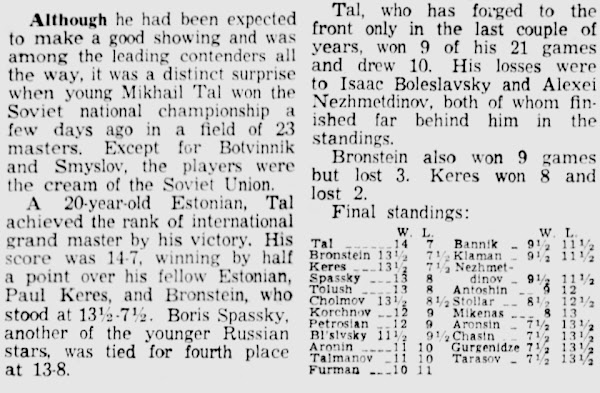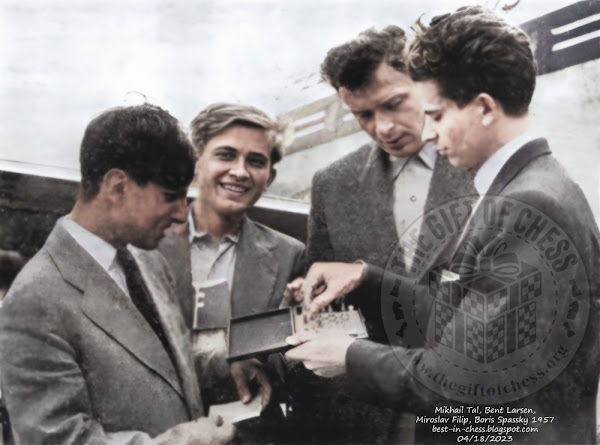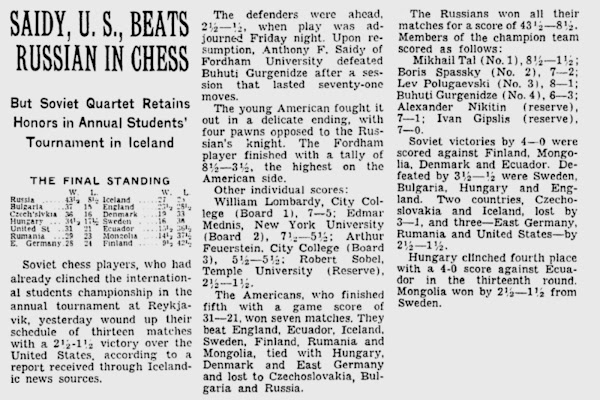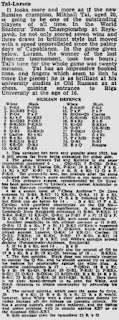March 09 1957
The Province, Vancouver, British Columbia, Canada, Saturday, March 09, 1957
New USSR Champion
An unassuming Estonian student, Mikhail Tal, 20, scored 14-7 in an extremely strong field to win the USSR national event completed Fed. 27. Tal beat Bronstein, Keres, Tolush, Petrosian and Taimanov—five of the nine grandmasters at the top of the event!
His splendid achievement netted Tal a gold medal, the Russian title and the coveted title of grandmaster.
Bronstein and Keres were runners-up with 13½-7½ each, followed by Tolush and Spassky, 13-8 each; Cholmov, 12½-8½; Korchnoi and Petrosian, 12-9 each; Boleslavsky, 11½-9½; Taimanov and Aronin, 11-10 each; and eleven other entries.
March 14 1957
Courier-Post, Camden, New Jersey, Thursday, March 14, 1957
Although he had been expected to make a good showing and was among the leading contenders all the way, it was a distinct surprise when young Mikhail Tal won the Soviet national championship a few days ago in a field of 23 masters. Except for Botvinnik and Smyslov, the players were the cream of the Soviet Union.
A 20-year-old Estonian, Tal achieved the rank of international grand master by his victory. His score was 14-7, winning by half a point over his fellow Estonian, Paul Keres, and Bronstein, who stood at 13½-7½. Boris Spassky, another of the younger Russian stars, was tied for fourth place at 13-8.
Tal, who has forged to the front only in the last couple of years, won 9 of his 21 games and drew 10. His losses were to Isaac Boleslavsky and Alexei Nezhmetdinov, both of whom finished far behind him in the standings.
Bronstein also won 9 games but lost 3. Keres won 8 and lost 2.
March 17 1957
The Boston Globe, Boston, Massachusetts, Sunday, March 17, 1957
The 1957 U.S.S.R. chess championship tournament brought forth a brand new name in big time competition—Mikhail Tal, an Estonian.
All of the Soviet big guns competed except Botvinnik and Smyslov who are engaged in the world championship match. Following Tal in the U.S.S.R. tourney were Bronstein and Keres, Spassky and Tolush. Stuck somewhere further down the line were Korchnoi, Petrosian, Boleslavsky, Taimanov and Furman.
We'll undoubtedly hear a lot more from this 20-year-old Estonian master. Botvinnik also won a Soviet championship at the age of 20. Will Tal aid history in repeating itself?
March 23 1957
The Gazette, Montreal, Quebec, Canada, Saturday, March 23, 1957
Mikhail Tal, 20-year-old Estonian student, scored a surprise victory in the USSR championship, 14-7 pts., ahead of Bronstein and Keres, 13½-7½ each. Tal defeated both, as well as Tolush, Petrosian and Taimanov, grandmasters all.
Mark Taimanov vs Mikhail Tal
USSR Championship (1957), Moscow URS, rd 2, Jan-22
Nimzo-Indian Defense: Normal Variation. Gligoric System Bernstein Defense (E56) 0-1
16. B-K3 P-K4!…Black is a P up and the K-side while white has some advantage in space.
18. Q-Q6…Wrestling with a crocodile!
19. P-N5 B-R6!…Swish!
24. K-N2 N-Q5…White loses only a couple of fingers instead of an arm!
Resigns…Q-K5ch is threatened, and if 31. QxQP, Q-N5 mate.
July 26 1957
The New York Times, New York, New York, Friday, July 26, 1957
Russian Students Clinch Chess Title
The Russian team clinched first place last night in the world student chess championship at Reykjavik, Iceland, according to a report received here.
Headed by two international grand masters, Mikhail Tal and Boris Spassky, the Russian team completed a 4-0 sweep against Ecuador in the eleventh round and then defeated Iceland, 3-1, in the twelfth.
The Russians have a score of 41-7, with one round remaining. Today they will oppose the United States team, which is fifth and likely to remain there, with a score of 29½-18½.
The American team, which is composed of college undergraduates, has been facing players many years older. Under the European rules, post-graduate students under the age of 30 are eligible for the tournament.
Arthur Feuerstein of C.C.N.Y. won his adjourned game with Theodor Ghitescu of Rumania to give the United States a 3-1 victory in the tenth-round match. Edmar Mednis of N.Y.U. defeated Svren Munhi of Mongolia in the final game of the twelfth-round engagement for a 4-0 sweep.
However, the American team bowed to Bulgaria, 3½-½, in the completion of adjourned eleventh-round games. William Lombardy of C.C.N.Y., Anthony F. Saidy of Fordham and Feuerstein were defeated.
July 27 1957
New York Times, New York, New York, Saturday, July 27, 1957
Russian Chess Team Defeats U.S. 2½-½
The Soviet team, which clinched the world student chess championship Thursday night, gained still another victory in the thirteenth and final round at Reykjavik, Iceland, last night, according to a report received here.
The Russians brought out their strongest team, from six players available, to face the United States quartet and triumphed, 2½-½, with one game adjourned until today.
William Lombardy of C.C.N.Y. agreed to a draw after sixteen moves with Mikhail Tal, the Soviet national champion, in a King's Indian defense, adopted by Tal. Edmar Mednis, N.Y.U., played the French defense against Boris Spassky, world junior champion, who won in thirty-one moves. Pressed for time, Mednis overlooked a chance to draw.
Playing at the third board, Arthur Feuerstein of C.C.N.Y. lost in twenty-nine moves to Lev Polugayevsky. Overestimating the force of his queen's fianchetto attack, Feuerstein refused Polugayevski's offer of a draw.
Anthony F. Saidy of Fordham, conducted the black pieces in an English opening against Bukhuti Gurgenidze at the fourth table and held his own throughout the five-hour session. At adjournment, the Fordham player said he believed he had the stronger position.
In other matches, Bulgaria swept the four boards with Finland to tighten its hold on second place. Rumania won by 2½-1½ from East Germany. England and Denmark played a 2-2 tie.
July 28 1957
New York Times, New York, New York, Sunday, July 28, 1957
Saidy, U.S., Beats Russian In Chess
But Soviet Quartet Retains Honors in Annual Students' Tournament in Iceland
Soviet chess players, who had already clinched the international students championship in the annual tournament at Reykjavik, yesterday wound up their schedule of thirteen matches with a 2½-1½ victory over the United States, according to a report received through Icelandic news sources.
The defenders were ahead, 2½-½, when play was adjourned Friday night. Upon resumption, Anthony F. Saidy of Fordham University defeated Bukhuti Gurgenidze after a session that laster seventy-on moves.
The young American fought it out in a delicate ending, with four pawns opposed to the Russian's knight. The Fordham player finished with a tally of 8½-3½, the highest on the American side.
Other individual scores:
William Lombardy, City College (Board 1), 7-5; Edmar Mednis, New York University (Board 2), 7½-5½; Arthur Feuerstein, City College (Board 3), 5½-5½; Robert Sobel, Temple University (Reserve), 2½-1½.
The Americans, who finished fifth with a game score of 31-21, won seven matches. They beat England, Ecuador, Iceland, Sweden, Finland, Rumania and Mongolia, tied with Hungary, Denmark and East Germany and lost to Czechoslovakia, Bulgaria and Russia.
The Russians won all their matches for a score of 43½-8½. Members of the champion team scored as follows:
Mikhail Tal (No. 1), 8½-1½;
Boris Spassky (No. 2), 7-2;
Lev Polugayevsky (No. 3), 8-1;
Bukhuti Gurgenidze (No. 4), 6-3;
Alexander Nikitin (reserve), 7-1;
Aivars Gipslis (reserve), 7-0.
Soviet victories by 4-0 were scored against Finland, Mongolia, Denmark and Ecuador. Defeated by 3½-½ were Sweden, Bulgaria, Hungary and England. Two countries, Czechoslovakia and Iceland, lost by 3-1, and three-East Germany, Rumania and United States-by 2½-1½.
Hungary clinched fourth place with a 4-0 score against Ecuador in the thirteenth round. Mongolia won by 2½-1½ from Sweden.
August 09 1957
The Guardian, London, Greater London, England, Friday, August 09, 1957
Tal-Larsen
It looks more and more as if the new Russian champion, Mikhail Tal, aged 20, is going to be one of the outstanding players of all time. In the World Students' Team Championship at Reykjavik, he not only scored seven wins and three draws in brilliant style but moved with a speed unparalleled since the palmy days of Capablanca. In the game given below, Larsen, the winner of the last Hastings tournament, took two hours; Tal's time for the whole game was twenty minutes. Tal has an impressive nose, and fingers which seem to itch to move the pieces; he is as brilliant at his university studies in Old Russian as at chess, gaining entrance to Riga University at the age of 16.
Mikhail Tal vs Bent Larsen
Reykjavik (1957), Reykjavik ISL, rd 7, Jul-??
Sicilian Defense: Najdorf Variation (B96) 1-0
1.e4 c5 2.Nf3 d6 3.d4 cxd4 4.Nxd4 Nf6 5.Nc3 a6 6.Bg5(1) e6(2) 7.f4 Bd7 8.Qf3 Nc6(3) 9.O-O-O Nxd4 10.Rxd4 Bc6 11.Be2(4) Be7 12.Rhd1 Qa5 13.Qe3 h6 14.Bh4(5) e5 15.fxe5 dxe5 16.R4d3 O-O 17.Kb1(6) Rfd8(7) 18.Bxf6 Bxf6 19.Nd5 Bg5 20.Qf3 Rac8(8) 21.b4 Qa4 22.Ra3 Rxd5 23.exd5(9) e4 24.Qc3 Bf6 25.Rxa4 1-0 |
- This variation has been very popular since 1955, but it still seems far from being exhausted for either side.
- The game between Tal and Kolarov in the same tournament continued 6. …QN-Q2; 7. B-QB4 Q-R4; 8. Q-Q2 P-K3; 9. Castles QR P-N4; 10. BxKP PxB; 11. NxKP K-B2; 12. NxB RxN; 13. QxP P-N5. Tal eventually won, but analysis after the game indicated that White's piece sacrifice is not quite correct.
- This defensive system, recommended by Dr. Euwe has been popularized by Larsen's win against Alexander in the last Hastings tournament.
- In a recent issue of “Chess Archives” Dr. Euwe suggests 11. B-B4 B-K2; 12. KR-Q1 Q-R4; 13. BxN BxB; 14. RxP Castles; 15. RxB followed by P-K5, but Black can do better by 14. … BxN; 15. PxB, Castles; with excellent counterplay on the QB file—White's extra pawn has no significance. A game Persitz-Lombardy from Reyjavik continued 11. B-B4 P-KR3; 12. B-R4 B-K2; 13. KR-Q1 Q-R4; 14. P-B5 PxP; 15. QxP QxQ; 16. PxQ Castles KR with equal chances.
Another possibility in this critical position is 11. P-B5 Q-R4; 12. BxN PxB; 13. B-K2 (O'Kelly's suggested improvement over 13. PxP Q-N4ch which Alexander played against Larsen), Q-K4; 14. KR-Q1 Castles; 15. Q-R3 P-KR4; 16. K-N1 P-R5; 17. B-B4 R-K1; 18. Q-Q3 K-N1; 19. BxRP and White's sacrifice proved decisive (Polugaevesky-Andersen, Reykjavik). - If 14. BxN, still 14. … BxB.
- White cannot immediately aim for control of Q5 by 17. BxN BxB; 18. N-Q5, because of 18. … B-KN4.
- The first mistake. Black does not seriously threaten to contest the Q file, and he should instead try to utilise his bishops for counterplay against the white king. A plausible continuation is 17. … P-QN4; 18. BxN BxB; 19. N-Q5 B-N4; 20. Q-B2 P-N5; 21. P-KR4 B-Q1; 22. Q-N3 B-QN4; 23. R(Q3)-Q2 BxB; 24. RxB R-K1; 25. R-B2 Q-N4; 26. R(1)-KB1 R-R2. Here there is no clear break-through to be seen for White, and Black threatens to obtain counterplay by advancing his QRP.
- The second mistake, which costs the game by force, 20. BxN; 21. RxB RxR; 22. RxR would, however, leave White with a clear advantage despite (or rather because of) the bishops on opposite colours. He has a strong queen's side pawn majority, and the bishop and queen combine well in attacks against KB7 or on the diagonal QN1-KR7.
- Still stronger than the immediate 23. RxQ.
November 21 1957
Courier-Post, Camden, New Jersey, Thursday, November 21, 1957
Arthur Bisguier and Larry Evans, two of the younger generation of American chess players and also two of its most successful players in national and international competition, have received one of the most highly coveted honors in the game.
They have been named international grand masters by the World Chess Federation, although both men rank as only masters in our national ratings, Samuel Reshevsky being our only active grand master.
Only two other players were selected as international grand masters this year. They were Mikhail Tal, 23-year-old new national champion of the Soviet Union, and B. Larsen, of Denmark.
William Lombardy, another one of our youthful stars, was among a group of 20 awarded the title of international master.
































